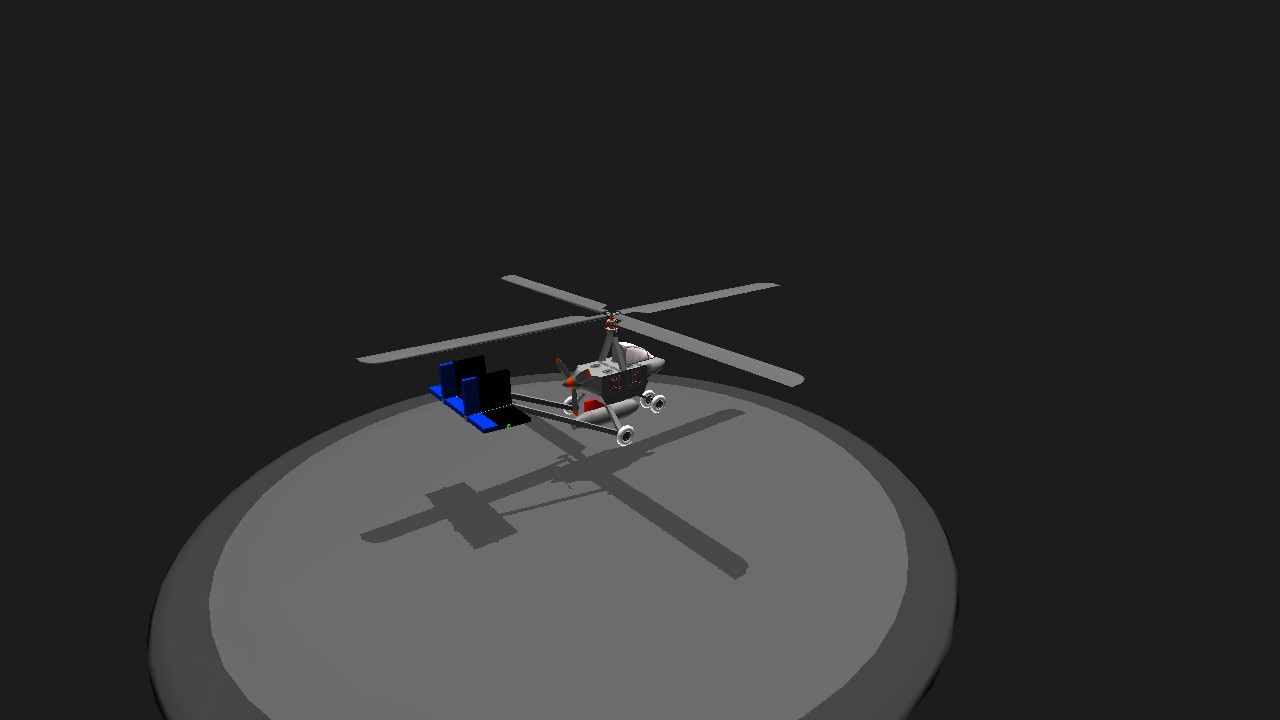Autogyro-T_Aircraft (T means test)
Autogyro,
-Level flight speed can reach 200mph
-Vibration will occur during take-off and flight, but it will not affect the control
Control method-
-4_ Abandon the auxiliary fuel tank
-8_ Turn on or off navigation lights(Left red, right green)
-VTOL_ The rotor can be turned up in advance, but the rotor output must be turned off when taking off, and it can take off almost vertically
Recommend others' autogyro
-JoshuaW-https://www.simpleplanes.com/u/JoshuaW
-ZWLenning-https://www.simpleplanes.com/a/f2px7X/Autogyro
Tips on the design and construction of autogyro
Regarding take-off (lift)-the main rotor mainly provides lift like a wing. It can rotate at the forward speed, but it can also activate the engine before take-off to make the rotor spin to generate lift (but because the rotor has a torque that is biased to one side, it cannot After taking off, it still relies on activating the engine to generate lift. You can increase the torque of the main rotor by adding rotors in other directions, but that is a helicopter) but after takeoff, you can only rely on the forward speed of the engine to accelerate the rotation of the main rotor to generate lift.
-The heavier the weight, the greater the lift required, but the lift of the autogyro is generated by the spin rotor, but the rotation speed of the rotor (RPM-Revolutions Per Minute) is limited. If a certain rotation speed is exceeded, the rotor will be too fast due to itself If the lift cannot be changed, you can reduce the weight or increase the diameter of the rotor (but if the diameter of the rotor is too large, it may cause vibration. Although you can increase the “Vibration Damping” value in the settings to prevent it from happening, the diameter of the rotor If it is too large, vibration may occur, making it difficult or even impossible to control. However, the problem of excessive rotor diameter can be solved by increasing the number of rotors. I guess the vibration phenomenon is caused by the asymmetric lift spacing between the rotors. If you increase the number of rotors, you can reduce the space between the rotors with asymmetric lift. The result is that increasing the number of rotors can reduce the occurrence of vibration) or increase the thickness of a single rotor to reduce the rotation speed of the rotor under the same lift.
(If the number of rotors of this autogyro is reduced to only two, it will often vibrate during flight)
The available position arrangement of the spin-rotor aircraft (does not mean that the other position arrangement is not available)-the position of the main rotor is aligned in the front and rear of the center of gravity (similar to a helicopter), and the engine and the center of gravity are aligned up and down (similar to a fixed-wing aircraft)
Other details-the sensitivity of the main rotor ("pitch"-nose lift and "roll"-fuselage roll) can be increased by increasing the "cyclic-pitch/roll (deg)" value to increase the sensitivity of the reaction
-Turn the preset main rotor into a autogyro. There are only two key controls for the main rotor, the angle of the rotor and the rotation of the rotor. One preset is the "VTOL" control, the other is the "Throttle" control, turn off the control They are fine, but you can also keep the control of the rotor rotation (helpful in the take-off phase), but be careful not to affect the flight after take-off. The "overload-mod" can be solved once and for all. Under the default "inputController" "The first is the rotation of the rotor, and the second is the control of the rotor angle. Delete the original number in the box to the right of "activationGroup" and enter "Disabled" to completely solve the possibility of accidentally turning on
-The rotation speed of the main rotor (RPM-Revolutions Per Minute) has nothing to do with the forward speed of the autogyro, which means that your forward speed will be too fast at 10mph and 200mph, and the rotation speed of the rotor is too fast and the forward speed Speed ??has nothing to do with
Specifications
General Characteristics
- Created On Android
- Wingspan 37.2ft (11.3m)
- Length 37.2ft (11.3m)
- Height 9.6ft (2.9m)
- Empty Weight 1,771lbs (803kg)
- Loaded Weight 2,484lbs (1,126kg)
Performance
- Power/Weight Ratio 45.235
- Horse Power/Weight Ratio 0.402
- Wing Loading 57.7lbs/ft2 (281.7kg/m2)
- Wing Area 43.1ft2 (4.0m2)
- Drag Points 2336
Parts
- Number of Parts 48
- Control Surfaces 6
- Performance Cost 331





